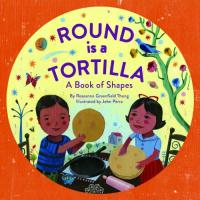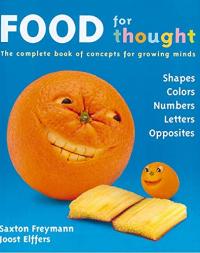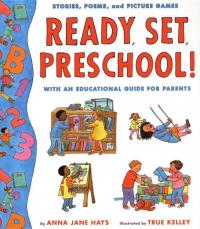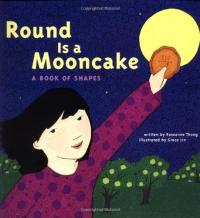
Everything one needs to know about triangles and angles is presented in a brief but informative and upbeat manner, all colorfully illustrated. A few triangle experiments are clearly delineated and illustrated and sure to engage and may lead to other activities.
Triangles

Moose and his friend Zebra (from Z is for Moose (opens in a new window)), are back, this time changing shapes, recognizing geometric shapes all around, and generally causing chaos within the pages of the book. Spirited illustrations create a witty tone for this engaging and surprisingly informative book.
Circle Square Moose

Die-cuts let readers ‘spy’ a portion of an animal while text provides clues as to what it might be. With the turn of the page the entire bird is portrayed. Basic characteristics and attractive illustrations provide an informative glimpse of a variety of fowl while playing a variant of a familiar game.
I Spy in the Sky

What can you see in shadows? A girl imagines she sees a crocodile and more — until the light returns with a click. Limited colors energetically depict her imagination. Her musings are reminiscent of shadow puppetry (and just may inspire creation of them, too).
Shadow

Bright colors and simple patterns on sturdy pages present simple images of familiar farm animals, enhanced by textured paper. On the opposite side of each page is a pattern that incorporates the animal.
Farm

Circles, squares, triangles, ovals and stars are all around! The rhyming text incorporates Spanish words which are defined in illustrations reminiscent of folk art. A glossary of Spanish words concludes this engaging glimpse into Mexican culture.
Round Is a Tortilla: A Book of Shapes

One animal’s claim is followed by others who are successively bigger, smaller, etc., each using rich (and richer) descriptors.
Big, Bigger, Biggest

Observing changing leaves and tree life cycles are appropriate in fall. Also try Snowballs (opens in a new window), Waiting for Wings (opens in a new window), Growing Vegetable Soup (opens in a new window), and Planting A Rainbow (opens in a new window) by Lois Ehlert for other seasonal science-related activities.
Leaf Man

The word “mom” has it; so does a butterfly. Once you know what it is, you see it everywhere! A clear introduction to the topic is presented in accessible language and crisp, well-labeled illustrations in a colorful format. Suggestions for activities, a lucid explanation of its importance in math, and a glossary conclude this attractive volume.
Seeing Symmetry

Putting yourself into the center of a book can be done literally. Black/white illustrations, minimal text, and a large hole encourage active participation in this unique book.
The Book with a Hole

At the start, the square was perfect and red but things change and so does the square. In a series of images accompanied by playful language, the red square changes into different forms and colors, challenging the reader to think literally outside of the box — that perhaps change isn’t such a bad thing after all.
Perfect Square

Four board books are included in a well-built cardboard case with a handle. Each concept is clearly, briefly presented in minimal text and cheery illustration, just right for young hands or for sharing.
Market Day! Colors, Shapes, Opposites, Numbers

Basic shapes are introduced on one side of each sturdy double page spread; on the opposing side, die-cuts hint at what is hidden. Lift the flap to see the shape in an easily recognizable object. A similar approach is used to introduce basic colors in both of these interactive books sure to hold up to small, rough hands.
See also: What Color Is Your Apple? (opens in a new window)
What Shapes Do You See?

Rich, alliterative language is used in intriguing similes to create a rhythmic text illustrated with bright colors and bold forms — animals created by one or many heart shapes. From the opening to the final page where a resting child cuddles with a teddy bear made from heart shapes, this book is sure to fascinate readers.
My Heart Is Like a Zoo

Lyrical language and textured collages poetically convey the wonder of patterns and shapes in moths, birds, and other creatures. A brief note concludes this handsome volume.
Bees, Snails and Peacock Tails

A girl tells readers about the birds she sees around her, describing size and color in spare, almost lyrical language. Richly colored paintings accompany the text to enhance and build the concepts presented in the narrative.
Birds

Bold color and geometric shapes create portraits of creatures from caterpillars to monkeys to accompany short ditties. The result is a lively look at a range of animals. Some short verse is reminiscent of Ogden Nash (“RAT/Leave/a rat/where/it’s at.”)
Oodles of Animals

Shake the shapes and what do you find? A host of triangles, squares, and more! What can you do with them? Make different things. Where can you see them? All around you! Geometric shapes in bold colors depict a cast of children finding, identifying, and playing with shapes — all to a rhythmic text.
Shape Capers

Stunningly intricate, handsomely colored paper sculptures jump out with each turn of the page. Readers of all ages will spend time on each double page spread to answer the questions posed and to admire the amazing engineering used to create this handsome book.
How Many: Spectacular Paper Sculptures

In this simple escapade, two young mice — Mouse and Minka — play in colorful fall leaves. Because the adventurers are small, focus remains on the earth-toned leaves for a simple, but satisfying time.
Mouse’s First Fall

Prepare for a visit to a French-speaking country as you count from one (1) to ten (10) or les nombres de un/une (1) a dix (10) in this brightly colored “first” book. Intended to build vocabulary, concrete objects or shapes accompany the word in both languages with a pronunciation guide to accompany the words introduced. Trying to learn Spanish? You’ll be interested in My First Spanish Book!
My First French Book: A Bilingual Introduction to Words, Numbers, Shapes, and Colors

Fruits and vegetables have distinct personalities — at least in the hands of the team that created How Are You Peeling. Here, expressive foods suggest shapes, colors, numbers, and more (as well as a range of emotions) in crisp, full-color photographs of fascinating food sculptures.
Food for Thought

Children and their parents are encouraged to get ready for preschool in stories, poem and games that deal with a range of skills and topics: basic shapes, friends, the alphabet, body parts, and more. Activities and information are vivified with cartoon-like illustrations that create movement and show the action. A note for parents completes this attractive package.
Ready, Set, Preschool: Stories, Poems and Picture Games

A girl discovers things that are round, square, and rectangular in her urban neighborhood. A gently rhyming text and crisply lined illustrations reveal many things that are universally recognizable as well as others that come from the child’s Chinese background.
